List of Authors
>>About this blog
Recent blog post
|
[Slow of Satsuki's Koi]
August 28, 2015 18:00
Cross the Kobashi (remains) and enter the Tsukiji Market, go to the right, and there is "Mizu Shrine" at the end.
There is a large stone monument "Hagiyama" beside it. "Hagiyama" has been asked several times in the Chuo-ku Tourism Certification.
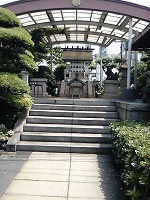 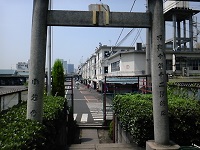 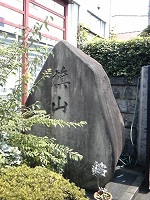
In this area, there was a naval facility, and when I was a child, I often talked to adults, "Navy Accounting School"
I remember that the word came out.
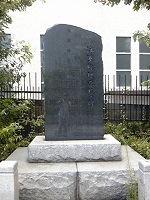 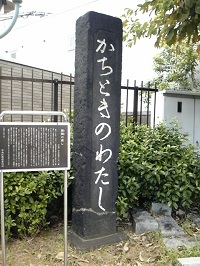
Naval Accounting School Stone Monument Handing of Kachidoki (located in Nishizume, Kachidokibashi)
The cafeteria is lined up between the seafood bridge (remains) and the water shrine.
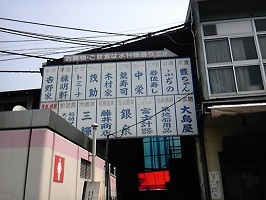
There is Yoshinoya's first store next to "Mizu Shrine".
The situation at that time is posted on the homepage, but this area is almost the same as in the past.
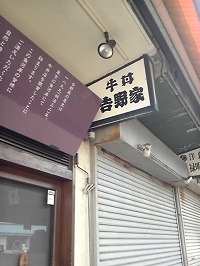 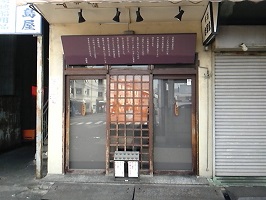
In the past, my parents' house ran a liquor store and served sake beer seasonings etc. in several cafeterias.
The other day, a Western restaurant in it was introduced on TV.
It seems that there is a store in the cafeteria where the owner has changed, but the name is the same as before.
This sushi restaurant had an English menu for foreign tourists.
In addition, there was an "Omakase course", but this "Omakase" seems to be unique to Japan.
(I was taking up "Omakase" on NHK's program.)

By the way, if you go through the hall and go to Hamarikyu, you will have a gentle curve here.
As you may know, this is where there was a wagon service line.
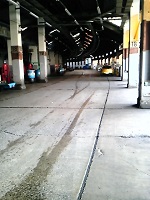 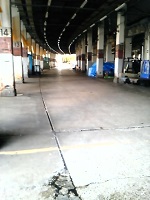
The rails are laid here, and when I was a child, the bicycle wheels were laid.
I remembered that I was taken by a rut and fell down and hurt.
This road from the front gate of the market to Hamarikyu (where there is a traffic light)
There was a railroad crossing, there was a hut beside, manned, and the circuit breaker was lowered.
In addition to passing the wagon, you can change points somewhere.
I wondered if I had been waiting for a long time with the circuit breaker.

[Sumida Fireworks]
August 21, 2015 14:00
Located in the city, the banks of the Sumida River are somewhat large in the sky.
I'm a countryside, or I'm just here in search of a wide sky.
 (May 25 From Kachidokibashi Waki toward Tsukiji Market) (May 25 From Kachidokibashi Waki toward Tsukiji Market)
There are many sunny days this summer, and I feel that there are many days when dusk is beautiful because of that.
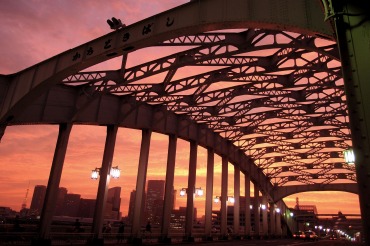 (June 27, Kachidokibashi) (June 27, Kachidokibashi)
At dusk, sometimes it becomes a wonderful drama after the sun sets.
Akane, orange, pink, blue. It emits unpredictable light.
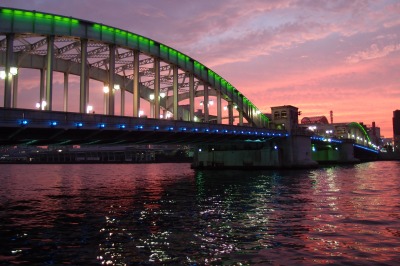 (June 27, Kachidokibashi) (June 27, Kachidokibashi)
If it is a riverside, the light is reflected on the river surface and the excitement is doubled.
I think the sunset on the riverside from Tsukuda, Tsukishima and Kachidoki, where you can see the direction of sunset over the Sumida River, is a particularly beautiful place.
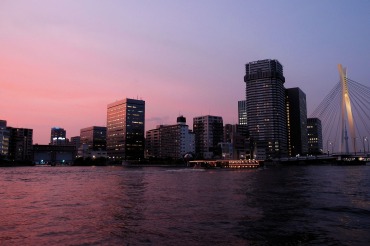 (8/4 from Tsukuda to Shinkawa) (8/4 from Tsukuda to Shinkawa)
But it does not mean that the sun sets is beautiful.
After the sun sets, the clouds exposed to light change from the supporting role to the leading role.
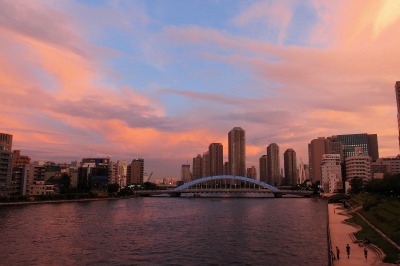 (7/15 from Sumida River Ohashi toward Eitai Bridge) (7/15 from Sumida River Ohashi toward Eitai Bridge)
Well, what kind of drama will it be today?
It's a few tens of minutes, but you can't read the development in the ever-changing evening sky.
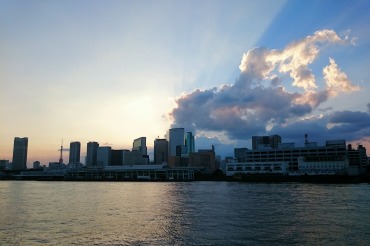 (8/9 from Kachidokibashi to Tsukiji Market) (8/9 from Kachidokibashi to Tsukiji Market)
It's a little cooler at dusk. I think there are many ways to enjoy it.
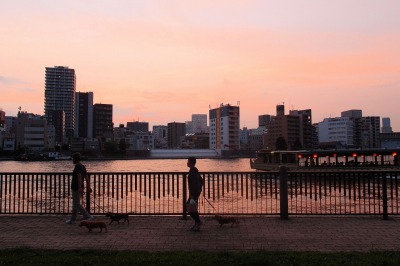
(Aug. 4 from Tsukuda to Minato)
I took a walk with a digital camera and a mobile phone.
The photo is left to the setting of the sunset mode of the digital camera. But sometimes mobile photos are more beautiful.
At dusk, it is a scenery where you can feel some nostalgia, but it is the same in the Sumida River.
At dusk in the city, I feel like nostalgia is more prominent.
It's going to be a little hotter.
Also, I would like to walk along the Sumida River at dusk in search of a new drama.
[Nojinya]
August 16, 2015 14:00
Do you know the road called Tokyo Kosoku Doro? It is an expressway that runs around Ginza from Shinkyobashi to Horai Bridge (Shimbashi). This road, which looks like a wall that protects the city of Ginza, if you have walked around Ginza, you may have always seen it. Appeared several times in my blog post ("Slightly Drinking at a liquor store in Ginza-Ginza Kimishimaya Shell" and others:
/archive/2015/08/post-2627.html), so I would like to take up this expressway this time.
Speaking of expressways, I think of national roads such as the Tomei Expressway, and the Metropolitan Expressway in Tokyo, but this 2 km long road that runs around Ginza was established in 1951 mainly by private companies (road opening was in 1959). It is an expressway that was done.
It is a road that also serves as a bypass for the Metropolitan Expressway Toshin Beltway by connecting with the Metropolitan Expressway Yaesu Line (Y) and Toshin Beltway (C1), so if you are a driver, you may have passed once before noticing. I think there is.
[Tokyo Kosoku Doro Map (Source: Tokyo Kosoku Doro Co., Ltd. HP)]
In addition, it is unique that the toll is free, even though it is on this road and highway.
Of course, in the case of getting in from the Metropolitan Expressway, for example, if you enter from Tsuchihashi Entrance (Ginza 8-chome) in front of Shimbashi Station and get off at Shinkyobashi (Ginza 1-chome), you will have to pay for it, and it seems that it was free because it was originally madeouter moat, Kyobashi and Shiodome rivers. On the other hand, there is a question about how to do construction costs and maintenance of expressways free of charge, but the secret is the use of space under expressways.
[Tokyo Kosoku Doro Conceptual Diagram (Source: Tokyo Kosoku Doro Co., Ltd. HP)]
While the third floor is used as an expressway, the lower space is a commercial space with about 400 stores. Ginza Ins, Nishiginza Department, Ginza Five, Corridor Street, Ginza Nine, etc. It is used as a space for taxi companies, parking lots, etc., as well as a familiar restaurant area such as Ginza Ins, Nishiginza Department, Ginza Five, Corridor Street, Ginza Nine, etc. We introduced the previous blog post "Public-Private Partnership (PPPP Partnership (PPPP) Partnership (PPPPPPPPPPPPP)", which uses the Roof-P), which covers the Roof-P), which covers the Roof" (P), which covers the public-P), which covers the cost of the cost of Edo Bus", which uses the cost of the cost of the cost of the public-PPPP), which uses the cost of the cost of the rental income obtained from the cost of the rental income obtained from the public-P), which uses the rental income from: /archive/2015/08/post-2618.html) is used to create a groundbreaking mechanism that preempts forward.
By the way, it is a shop under Tokyo Kosoku Doro, but there are attractive shops such as Ginza Kimishimaya, a standing drinker introduced at the beginning. From the next time, I would like to introduce it one by one in "Chorror Visiting Shopping Streets". I'm looking forward to it!
[Nojinya]
August 12, 2015 14:00
Last time, we introduced an antenna shop in Chuo-ku as "Heisei no Kurayashiki in Chuo-ku-Part 1-" (/archive/2015/08/-in-3.html).
After the unification of the world by Nobunaga and Hideyoshi, rice and product transactions began to be active throughout the country. It started with the construction of an office and warehouse (= Kurayashiki) as part of the clan residence in Edo, where the shogunate is located.
This time, we will take up regional banks ("local banks"), which are regional financial institutions that represent the region, as Heisei's Kurayashiki-Part 2. The Tokyo branch of the regional bank supports the expansion of local companies in Tokyo, and it can be said that it is a modern version of warehouse that is often found in Chuo-ku, the center of Tokyo.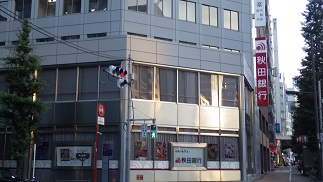
[Akita Bank (Kyobashi / Kajihata-dori)]
By the way, the number of regional banks throughout Japan (the first regional bank that is a member of the National Regional Bank Association) is 64, but although the exact number is unknown, nearly 90% of them are probably Nihonbashi, Kyobashi and Yaesu. It seems that they have a Tokyo branch in Chuo-ku. This is, of course, closely related to the Bank of Japan. 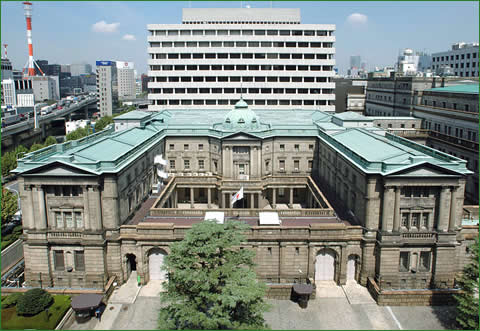 Bank of Japan (Honishi-cho) Bank of Japan (Honishi-cho)
Just as the daimyo set up a clan residence as a contact point with the Shogunate along with the purpose of residence of the family in Edo, the regional banks also set up services to business partners in Tokyo and receive supervision (examination) from the Bank of Japan. It seems that it was placed in Chuo-ku, the knee of the Bank of Japan.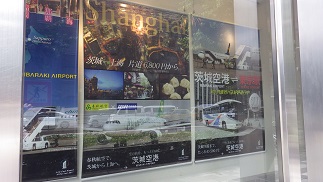
[Joyo Bank Show Window (Yaesu / Kajibashi Crossing])
Since it is the Tokyo branch of such a solid regional bank, there are many show windows that are relatively plain, such as introducing local specialties and famous places, but overturning such images at Hatchobori 2-chome intersection where Yaesu Street and Heisei Street intersect. Tokyo branch of a certain regional bank.
"OKB3 birth " 。 。 There is a flashy poster of a beautiful sister three, and I'm a little surprised! It's " 。 。 There is a flashy poster of a beautiful sister three, and I'm a little surprised! It's  a launch like a Ginza club rather than a local bank a launch like a Ginza club rather than a local bank  with a solid image. with a solid image.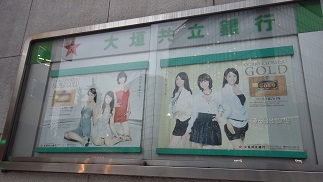
AKB's non-OKB is an acronym for Ogaki (Ogaki) Kyoritsu (Kyoritsu) Bank (Bank), an idol unit certified by Yasushi Akimoto, which was formed by recruiting members from female employees on their own. . In addition, OKB45 (45 people) has been added to OKB3, and it seems to be OKB48 in total. This is a remarkable bank PR, and OKB45 is also attracting events such as shopping streets around Gifu Prefecture. It seems that Ogaki Kyoritsu Bank is famous as an attacking bank in the industry, but according to a friend living in Gifu, Ogaki is a general store called "OKB Ranch" that is not an OK ranch (the naming is soft, but the Ogaki Kyoritsu Bank established It seems to be a regional bank with a fairly innovative culture. Thanks to such efforts, this bank ranked fourth in the Nikkei Financial Institution Ranking Survey (January 2015), which competes with high customer satisfaction, pushing megabanks and foreign banks.
[Toho Bank (Kyobashi / Chuo-dori)]
Enjoyment unique to Chuo-ku, where regional banks accumulate. Since it is a bank, you can't easily enter the store like an antenna shop, but if you find a colorful signboard in the city, why not look at the show window a little? There may be a new discovery.
[Sam]
August 11, 2015 18:00
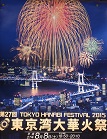 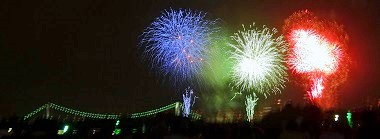
The 27th Tokyo Bay Fireworks Festival, which colors the night sky of Tokyo Bay, was held on August 8 at Harumi Wharf.
Last year it was canceled due to stormy weather, and it was held for the first time in two years.
A total of about 12,000 fireworks were launched from three boats off the Harumi Wharf + Harumi Wharf Park in total.
From 18:50 to 20:10, progress along the program.
Part 1 Tokyo Bay Fireworks Festival, Grand Opening
Part 2 Summer vacation, fireworks picture diary of memories
Part 3 Tokyo Bay, New Wave Fireworks Performance
Part 4 Edo Fireworks, Crafts and Traditional Feast
Part 5: The Dance of the Sky, Tokyo Bay
Part 6 Tokyo Bay Fireworks Festival, Grand Finale ~ Bridge to the Future ~
Among them, large balls such as 12 shaku 5 inch balls (about 45cm in diameter, about 400m above and covering the night sky) and 130 shaku balls are impressive.
Before the big fireworks blossom with "Dodon", you will be excited by the sound of the familiar "Hugh" whistle.
It is full of pyrotechnician's creativity, ingenuity, and skills, ranging from traditional techniques such as Yae-Kin Chrysanthemum, where light pulls the tail and spherical shape and the core layer, and Senwa Chrysanthemum, where small flowers open all at once.
The refreshing wind blowing along the sea surface was also felt, and it was somewhat easy to survive, and it was literally a "Noryo Fireworks Festival".
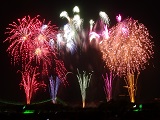 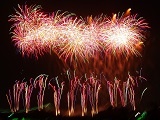 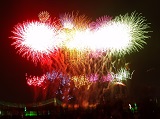
 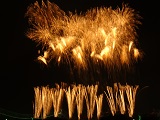 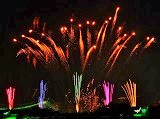
  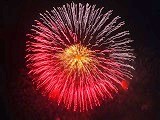
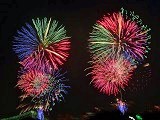 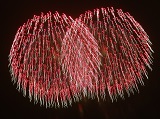 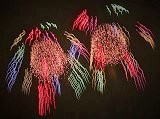
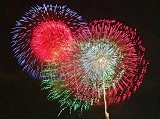 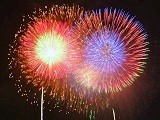 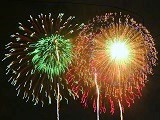
The Tokyo Bay Fireworks Festival, along with the Sumida River Fireworks Festival and the Jingu Gaien fireworks festival, is one of the representative fireworks festival in Tokyo.
Of the venues around Harumi, where about 100,000 seats are set up (sponsored by Harumi, Harumi Daini, Toyosu Daiichi, Hinode, Harumi individually), the Harumi area is involved in the development of an athlete village for the 2020 Tokyo Olympics. Some say that the Tokyo Bay Fireworks Festival will be suspended because it will be restricted from next year.
Some media reported that "de factoly look over this year", and it seems that it has become a reality.
More The 27th TOKYO HANABI FESTIVAL 2015
[Old Rose]
August 9, 2015 18:00
Last Saturday, before attending a lecture at the Tsukiji Reservation Study Group starting at 2:00 pm
We had a break at Akatsuki Park. at Akatsuki Park.
Then there was a sweet scent like "Pu-n". a sweet scent like "Pu-n".
When I approached the scented side, there was a large fig tree. a large fig tree.
It was still blue, but it had a lot of fruit.
Sitting on the bench in the park and starting to drink tea
I just heard the bell of lunch, and I heard the bell of a rhythm that I rarely heard. lunch, and I heard the bell of a rhythm that I rarely heard.
Is it a kind of hymn?
By the way, this Tsukiji Reservation Study Group is "The Founding Story of Kyobunkan".
Surprisingly, the original author of "Hanako and Ann" as a special guest
Eri Muraoka's sisters were participating.
I have been participating in this meeting for the second time.
There is a surprise every time, and I like the atmosphere that I couldn't taste at this meeting.
[NPO Tsukiji Reservation Study Group] http://www.tsukiji-kyoryuchi.com/
|
Links
|
 (May 25 From Kachidokibashi Waki toward Tsukiji Market)
(May 25 From Kachidokibashi Waki toward Tsukiji Market) (June 27, Kachidokibashi)
(June 27, Kachidokibashi) (June 27, Kachidokibashi)
(June 27, Kachidokibashi) (8/4 from Tsukuda to Shinkawa)
(8/4 from Tsukuda to Shinkawa) (7/15 from Sumida River Ohashi toward Eitai Bridge)
(7/15 from Sumida River Ohashi toward Eitai Bridge) (8/9 from Kachidokibashi to Tsukiji Market)
(8/9 from Kachidokibashi to Tsukiji Market)



 Bank of Japan (Honishi-cho)
Bank of Japan (Honishi-cho)




















